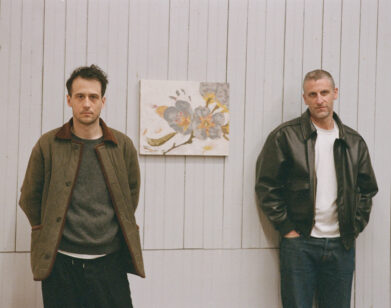Melt-Down in Berlin

In honor of the 20th anniversary of the fall of the Berlin Wall, the German Embassy in London invited artist duo Awst & Walther to create an installation. Situated outside the embassy on a busy road, “Work in Progress” consisted of bricks made entirely from solid ice stacked into a 11 ½-foot-high wall that shimmered under industrial-strength film lights. At the end of its installation day, the artists knocked down the parts that remained unmelted.
Manon Awst was born in the Ilse of Anglesey, Wales, and studied architecture at Cambridge. She collaborates with her husband Benjamin Walther, a former theatre director from Dresden who studied art history and philosophy at Berlin’s Humbolt-Universitat. Together, they have created a body of work using gelatin, ice, gold, glass, feathers and other unconventional art materials to investigate power dynamics, notions of luxury and status and divisions between our bodies and our consciousness.
ANA FINEL HONIGMAN: How was the experience of producing this show different for each of you considering your different historical backgrounds?
MANON AWST & BENJAMIN WALTHER: On an artistic and intellectual level, we were both working on the same ground and so it developed very naturally. But for Benjamin, who grew up in East Germany, the project had a further emotional impact: The history of the wall is interwoven into his biography, and his family’s biography.
HONIGMAN: Why did you decide to dismantle the wall instead of allowing the ice to melt naturally?
THE ARTISTS. PHOTO BY MAXIME BALLESTEROS
AWST & WALTHER: The core of the installation was made entirely of ice – a material that inevitably speaks of time. To allow it to melt entirely would have been conceptually misleading. The point we wanted to focus upon was that people took history into their own hands. Time has the potential to remove walls, but human beings do too.
HONIGMAN: How do you think this project relates to your body of work?
AWST & WALTHER: The piece touches upon subjects of division and exclusion. In the piece an essential part is the construction site that surrounds the core. These are themes that are generally present in our work. One of our recent gelatin sculptures, Over My Dead Body, separates the gallery space into two halves. It deals with very similar themes to Work in Progress, and furthermore refers to the fragile line between life and death.
HONIGMAN: What about the materials?
AWST & WALTHER: The dominant material in the installation is ice. It is a material we have worked with often. What struck us with Work in Progress is that, at first daylight, it shone like a jewel under the bright light of the industrial lamps. It became an ethereal monument, fragile and precious, and described for us what a moment is and what a memory can be.
HONIGMAN: What are the primary themes in your work that unify your process and interests?
AWST & WALTHER: Another fascination is surface—its capacity to seduce and its vulnerability to reveal what’s unseen or hidden.
HONIGMAN: You mention in the press material that the process of re-unification is still occurring. What do you feel still needs to be done to complete the process?
AWST & WALTHER: Over the last twenty years the encounter between East and West Germany has involved ignorance and narrow-mindedness. The wounds need to be healed and we think this requires communication and willingness to overcome prejudices.






